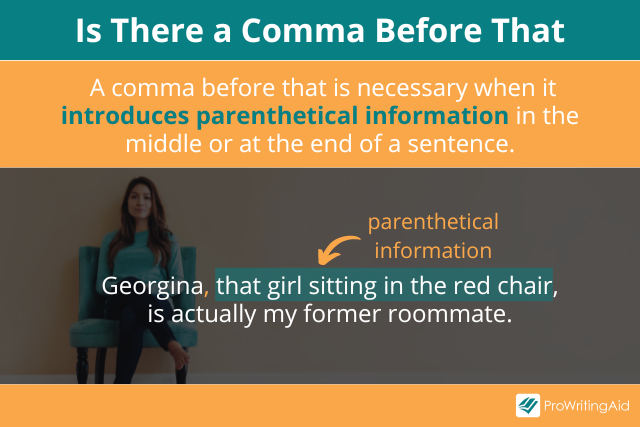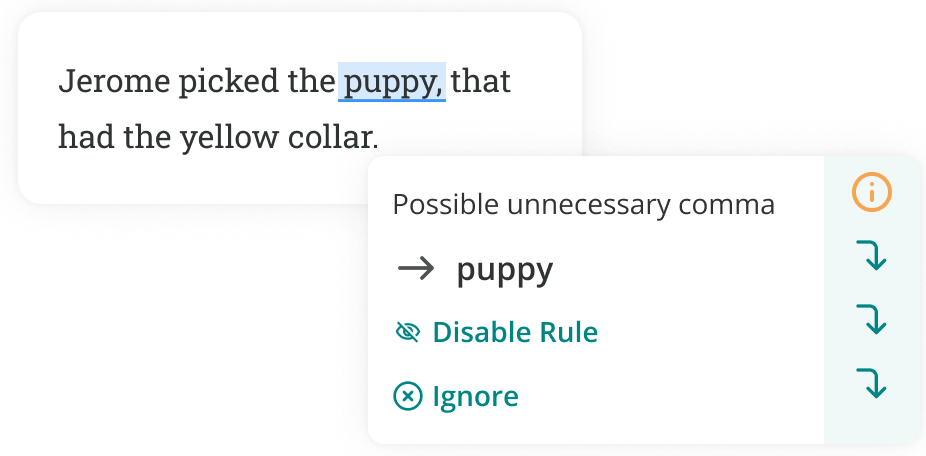
Commas are one of the most common punctuation marks in English, but they’re also one of the trickiest to use.
There are so many rules around comma usage, and they vary according to different circumstances.
For example, is it grammatically correct to use a comma before that?
You need a comma before that when the word is introducing parenthetical information anywhere in a sentence, plus a few other instances.
In this article, we’ll show you when to use commas before that, along with examples to help you get it right every time.
Is There a Comma Before That or After That?
You should use a comma before that when it introduces a parenthetical phrase. You should use a comma after that when it closes a parenthetical phrase.
A parenthetical element adds additional information and color to a sentence, but isn’t essential to the overall meaning.
For example:
- Georgina, that girl sitting in the red chair, is actually my former roommate.
In the example above, “that girl sitting in the red chair” provides extra information, or what’s referred to as non-essential or non-restrictive information. If you remove it from the sentence, the meaning remains the same.
Parenthetical phrases always need enclosing with punctuation marks. These can include commas, curved brackets, square brackets, or dashes. These punctuation markers are a useful way to identify non-restrictive information.

When to Use a Comma Before That
A comma before that is necessary when it introduces a parenthetical phrase in the middle or at the end of a sentence. For example:
- I won’t make that mistake again, that’s for sure.
- He doesn’t want to go to university, that much is obvious, he just wants to please his parents.
In these contexts, the comma acts as a parenthetical comma that offsets the parenthetical expression.
Another way to use a comma before that is when writing the parenthetical phrase that is. This is a shortened version of that is to say.
For example:
- The South American countries, that is, Brazil, Colombia, and Argentina, were doing very well economically.
Here, the clause that is is an introductory parenthetical phrase within a larger parenthetical element—one that begins with that and ends with Argentina.
It’s also grammatically correct to include a comma before that when it’s used in the middle of a list. Normally, a comma would not precede the first term in a list.
- Which dress is your favorite? This one, that one, or the other one?
When to Use a Comma After That
A comma after that is necessary if it occurs at the end of a parenthetical element in the middle of a sentence. This is because the comma is acting as a closing parenthetical comma.
- He threw a bar stool across the room, though I didn’t witness that, and was thrown out of the party.
If the parenthetical phrase occurred at the end of the sentence, there would be a period after that, rather than a comma.
You should also use a comma after that when it’s a term at the start or in the middle of a list. In the example below, the comma is acting as an Oxford comma, rather than a parenthetical comma.
- I’m not sure Hannah’s free today. She’s doing this, that, and the other.
No Comma Before That or After That
So when shouldn’t you use a comma before or after that? When there’s no need for a parenthetical comma, or when that is not part of a list.
This means you shouldn’t use a comma when that is functioning as an adjective, pronoun, determiner, adverb, or conjunction.
In particular, you shouldn’t use a comma before or after that when it’s used to join the main clause with a restrictive relative clause.
A relative clause is a type of subordinate clause that starts with a relative pronoun, such as that, who, when, which, or where. Relative clauses can be restrictive or nonrestrictive. A restrictive clause contains essential information.
For example:
Incorrect: Your mom mentioned, that you were upset.
Incorrect: Your mom mentioned that, you were upset.
Correct: Your mom mentioned that you were upset.

In the example above, “that you were upset” is a restrictive clause because it contains the essential details. Without it, the sentence loses its meaning. You shouldn’t use a comma to set apart a restrictive clause.
Parenthetical elements are nonrestrictive clauses because they contain information that isn’t essential to the meaning of the sentence. That’s why we use commas or another type of parentheses to set these phrases apart.
Commas aren’t used before or after that in an indirect statement either. An indirect statement is a form of subordinate clause. It’s used for reporting what someone said or wrote without using their exact words.
Notice how a comma is not appropriate before or after that in this example:
- Jerry said that he was going to buy a new car.
Examples of That in Sentences
Let’s look at a few grammatically correct examples of how to use a comma before that.
- He didn’t want to lose her friendship, that would be agonizing, but it was his only option.
- Julia, that girl over there, is actually my former roommate.
- My new coat, that one with the navy stripes, is missing a button already.
- Eric, that’s his wife over there, is the new chairman.
- Jake, that is, my younger brother, is going to summer camp next month.
Final Thoughts on Comma Before That
Let’s summarize what we’ve learned about the correct way to use a comma before that.
If that introduces a parenthetical expression, then it must be preceded by a comma. You should use a comma before that if it appears in the middle of a list too.
Other than these two instances, there’s no need for a comma before that if it’s carrying out its other functions—as an adverb, pronoun, determiner, conjunction, or adjective.

If you’re concerned about making grammatical mistakes in your work, ProWritingAid will pick up any instances of missing or misused commas.


